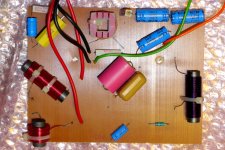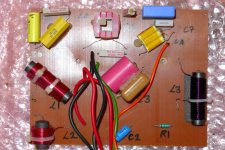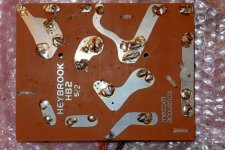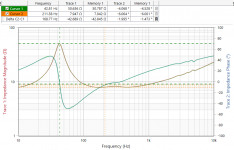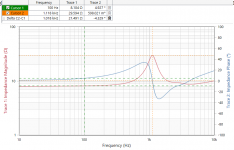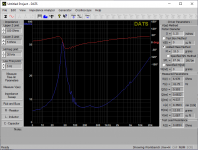HB2 maintenance
Hi! I joined this forum specifically to follow this thread.
I have a pair of HB2s which I bought new in 1982, from Holborn HiFi in Aberdeen (who are also still going strong). I have tried others: Linn Kans, Harbeth ML, and a couple of the newer KEF "UniQ" equipped floor standers but I always come back to the HB2s (previously I had a pair of Audiomaster MLS1s). The baffles have disintegrated, as has the foam damping in the ports. The bass drivers have occasionally suffered from rubbing and I now suspect this is due to the sagging frames Petercom has mentioned. I have rotated them a few times and all is good. Most seriously, at times both tweeters have gone open-circuit (which may have been due to a misbehaving amplifier) but I put them under my microscope and was able to find the breaks in the voice coils, just as they crossed the edge of the spider. It was a headache but I was able to slice fine wires across the gap and restore both. The magnet gaps are so large there were no re-centering problems.
Now I have the crossover circuit I shall look at refurbishing these and hope to keep them going another few decades.
Hi! I joined this forum specifically to follow this thread.
I have a pair of HB2s which I bought new in 1982, from Holborn HiFi in Aberdeen (who are also still going strong). I have tried others: Linn Kans, Harbeth ML, and a couple of the newer KEF "UniQ" equipped floor standers but I always come back to the HB2s (previously I had a pair of Audiomaster MLS1s). The baffles have disintegrated, as has the foam damping in the ports. The bass drivers have occasionally suffered from rubbing and I now suspect this is due to the sagging frames Petercom has mentioned. I have rotated them a few times and all is good. Most seriously, at times both tweeters have gone open-circuit (which may have been due to a misbehaving amplifier) but I put them under my microscope and was able to find the breaks in the voice coils, just as they crossed the edge of the spider. It was a headache but I was able to slice fine wires across the gap and restore both. The magnet gaps are so large there were no re-centering problems.
Now I have the crossover circuit I shall look at refurbishing these and hope to keep them going another few decades.
I have just completed a rebuild of my HB2s, including replacing the tweeter coil with the latest Audax version (RW025A0 supplied by Falcon Acoustics) and a re-working of the cross-overs. In doing this I have discovered errors in all the schemtics published here. The CAD drawing (as shown by system7) is prossibly the closest but I found these differences:
C6 is a 10uF 50V NP electrolytic, not 3u3
L4 (air-cored) measures at 382uH, not 2mH
C3 was built from 4u7 and 2u2 film caps in parallel (6u9, not 6u8)
The last was probably a response to a supply problem but the other value differences would make any of the above attempts to model the response inaccurate.
Most of the electrolytics were within spec. on value and ESR, but the 2u2 (C5,C7) were significantly higher in capacitance and with an ESR spread of 2.5 - 6.5 ohm.
I replaced C6 with a 10uF 100V film part, C4 with 3, parallel 2uF film caps, and (C5, C7) with 1uF MKT and 0.1uF PPS parts in parallel (to give the required 1u1). I also anchored all parts with hot-melt adhesive.
The end result is most pleasing
C6 is a 10uF 50V NP electrolytic, not 3u3
L4 (air-cored) measures at 382uH, not 2mH
C3 was built from 4u7 and 2u2 film caps in parallel (6u9, not 6u8)
The last was probably a response to a supply problem but the other value differences would make any of the above attempts to model the response inaccurate.
Most of the electrolytics were within spec. on value and ESR, but the 2u2 (C5,C7) were significantly higher in capacitance and with an ESR spread of 2.5 - 6.5 ohm.
I replaced C6 with a 10uF 100V film part, C4 with 3, parallel 2uF film caps, and (C5, C7) with 1uF MKT and 0.1uF PPS parts in parallel (to give the required 1u1). I also anchored all parts with hot-melt adhesive.
The end result is most pleasing
HB2 cross-over: pictures
I have attached some photos of the "before" and "after". The capacitors I used were just the ones I had in stock and not necessarily the optimum. They certainly used a lot of solder back then!
I have attached some photos of the "before" and "after". The capacitors I used were just the ones I had in stock and not necessarily the optimum. They certainly used a lot of solder back then!
Attachments
Heybrook HB2 coil: 2mH vs 0.2mH
Steve I have to agree with you on it likely being 0.2 mH. In a 2020 entry on the HB2s you posted photos of the xover. If that were a 2mH air core, given its small size, the wire diameter would have to be tiny which would, I presume, lower its power capability & dramatically increase the DCR. I think it must be a 0.2mH & as you pointed out that would be appropriate for a 3rd order filter.
Ah, the wrath of sreten falls on Heybrook!
But really, we aren't getting very far on this. It's time for some proper analysis.
An externally hosted image should be here but it no longer works. Please upload images instead of linking to them to prevent this.
An externally hosted image should be here but it no longer works. Please upload images instead of linking to them to prevent this.
See, we KNOW that LCR with the 560R might as well not be there. The 15R + 2X 2.2uF is actually a 15R +1uF Zobel, which actually does almost nothing either, because it has no series filter resistance to work with.
But it's that little (L4?) nylon bobbin air coil that is bothering me. Like I say, 0.2mH or thereabouts would make sense for a third order filter. I'm also guessing the tweeter could be wired in reverse polarity, but that's a guess.
Steve I have to agree with you on it likely being 0.2 mH. In a 2020 entry on the HB2s you posted photos of the xover. If that were a 2mH air core, given its small size, the wire diameter would have to be tiny which would, I presume, lower its power capability & dramatically increase the DCR. I think it must be a 0.2mH & as you pointed out that would be appropriate for a 3rd order filter.
I ought to drop in here more often it seems!
Look, that's my sketch of the HB2 crossover that system7 posted and it clearly shows a 0.4mH air core for the treble circuit. So I don't understand this discussion of L4 being 2mH or 0.2mH? It's 0.4mH, that's it.
You're welcome to leave out the bridge circuit with 560 Ohm resistor if you wish. The difference having it in is very subtle and can't be measured, even though it can be heard. We thought it was worth it at the time (we'd have been stupid to spend the extra pounds on the components, which ate into profits, otherwise), but you can decide.
Similarly the crossover layout, with widely spaced components and angled coils, is critical and caused us a lot of work to get into production to achieve the same sound as our external hand-wired crossovers in the prototypes.
In terms of replacing the caps, note that we preferred the sound of reversible electrolytic (ELCAP type) in the positions shown because of their ESR characteristic. Replacing these with modern PP types will improve detail but you might find the treble to be a little harsh as a result, especially with digital sources.
Remember that these speakers were voiced with LP and the overall power response is balanced to suit vinyl sources.
Look, that's my sketch of the HB2 crossover that system7 posted and it clearly shows a 0.4mH air core for the treble circuit. So I don't understand this discussion of L4 being 2mH or 0.2mH? It's 0.4mH, that's it.
You're welcome to leave out the bridge circuit with 560 Ohm resistor if you wish. The difference having it in is very subtle and can't be measured, even though it can be heard. We thought it was worth it at the time (we'd have been stupid to spend the extra pounds on the components, which ate into profits, otherwise), but you can decide.
Similarly the crossover layout, with widely spaced components and angled coils, is critical and caused us a lot of work to get into production to achieve the same sound as our external hand-wired crossovers in the prototypes.
In terms of replacing the caps, note that we preferred the sound of reversible electrolytic (ELCAP type) in the positions shown because of their ESR characteristic. Replacing these with modern PP types will improve detail but you might find the treble to be a little harsh as a result, especially with digital sources.
Remember that these speakers were voiced with LP and the overall power response is balanced to suit vinyl sources.
Hi!!
I managed to pick up a pair of HB2’s, and HB5’s for a mighty £12.50! The tweeter had been pushed inside one of the HB5’s and a couple of the binding posts have come off but otherwise they are all good! Love the sound of both sets. I can’t find hardly any info about the HB5’s . Does anyone know anything about these speakers?
Many thanks for this informative thread. I used to live in Ivybridge and went to school there for a couple of years so am glad to own some speakers that were in some way conceived there!
I compare the HB5’s to my Mission 752’s. They are similar in their tight accuracy. The HB2’s are a sound of their own and I am really enjoying them.
I managed to pick up a pair of HB2’s, and HB5’s for a mighty £12.50! The tweeter had been pushed inside one of the HB5’s and a couple of the binding posts have come off but otherwise they are all good! Love the sound of both sets. I can’t find hardly any info about the HB5’s . Does anyone know anything about these speakers?
Many thanks for this informative thread. I used to live in Ivybridge and went to school there for a couple of years so am glad to own some speakers that were in some way conceived there!
I compare the HB5’s to my Mission 752’s. They are similar in their tight accuracy. The HB2’s are a sound of their own and I am really enjoying them.
The HB2 was usually a plastic polycone Midbass, Audax HD17 IIRC.
The HD5 looks like a Kevlar cloth midbass. The Yellow colour was fashionable, and it looks like Audax.
Harder sound, Kevlar, has a bit more breakup. A sound B&W promoted.
The HB2 used the Audax Bextrene cone HD17B25H - 17 is the bass unit size in cm, B is Bextrene, 25 is the VC dia in mm, H is the largest magnet fitted to this unit.
AFAIK there are no satisfactory replacements that match the crossover as the latter had elements to tailor the response to subdue the upper midrange colorations of Bextrene.
By 'HB5' I suspect you mean HB Point Five or HB.5. The former was the lowest cost design I did for Heybrook and used an Elac bass unit (black cone).
The HB.5 looks as though it was designed after Heybrook was bought by Audio Partnership who often used Peerless India drivers. These look like a yellow, woven cone so could well be Kevlar.
It's all a complete muddle, IMO. There seem to be THREE HB point 5 models! 
I still have the 6" paper basses used in the original, AFAIK. Rather good. Rubber dustcacps as usual with Elac 8" too. The Elac 180NS10 used by Mordaunt Short in the old MS15:
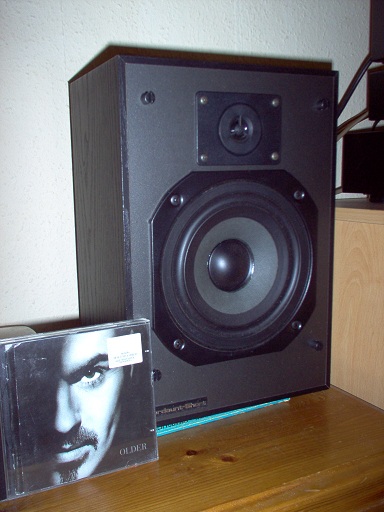
But there is a much later yellow cloth-coned HB.5 model too (don't know how long the link will last...):
Heybrook Hb5 Bookshelf Speakers For Sale in Dublin 8, Dublin from ganyani
And there is an intermediate model with what looks like the Elac painted yellow. You sort it out Pez101...
I still have the 6" paper basses used in the original, AFAIK. Rather good. Rubber dustcacps as usual with Elac 8" too. The Elac 180NS10 used by Mordaunt Short in the old MS15:
But there is a much later yellow cloth-coned HB.5 model too (don't know how long the link will last...):
Heybrook Hb5 Bookshelf Speakers For Sale in Dublin 8, Dublin from ganyani
And there is an intermediate model with what looks like the Elac painted yellow. You sort it out Pez101...
My HB2’s I’m sure are all original parts.
The HB.5 are the ones in the link above with the yellow drivers.
Petercom do you still live in Devon? I used to love walking my dog along Heybrook Bay and having a pint on the balcony at The Eddystone. Saw a Peregrine Falcon on a walk there once. It’s a lovely spot.
The HB.5 are the ones in the link above with the yellow drivers.
Petercom do you still live in Devon? I used to love walking my dog along Heybrook Bay and having a pint on the balcony at The Eddystone. Saw a Peregrine Falcon on a walk there once. It’s a lovely spot.
I found some excellent photos of the insides of the original HB point 5:
Inside Hi-Fi: Heybrook Point Five
Midbass is the slightly bespoke 180HB05 paper Elac unit in a biggish closed box it seems. Tweeter is a metal SEAS 19TAF/G familiar to most of us. Apparently the midbass runs unfiltered, the tweeter is (3.3R?) resistor and single (3.3uF?) filter with a shunt metal oxide resistor which is around 47R at a guess.
The shunt resistor must keep the high frequencies from going open circuit thus avoiding radio frequency pickup at a guess.
Inside Hi-Fi: Heybrook Point Five
Midbass is the slightly bespoke 180HB05 paper Elac unit in a biggish closed box it seems. Tweeter is a metal SEAS 19TAF/G familiar to most of us. Apparently the midbass runs unfiltered, the tweeter is (3.3R?) resistor and single (3.3uF?) filter with a shunt metal oxide resistor which is around 47R at a guess.
The shunt resistor must keep the high frequencies from going open circuit thus avoiding radio frequency pickup at a guess.
OK, it was a mistake. I took them apart and retraced the ground connection.
These were with #1 son for a few years until he blew out the HD17B25H woofers and replaced with Dayton units. (They are only good to 25W or so). However, I had a sealed box speaker with these drive units and unused for decades! Performing some measurements. Sadly, my Audax catalog has long since disappeared.
These were with #1 son for a few years until he blew out the HD17B25H woofers and replaced with Dayton units. (They are only good to 25W or so). However, I had a sealed box speaker with these drive units and unused for decades! Performing some measurements. Sadly, my Audax catalog has long since disappeared.
Attachments
I found some excellent photos of the insides of the original HB point 5:
Inside Hi-Fi: Heybrook Point Five
Midbass is the slightly bespoke 180HB05 paper Elac unit in a biggish closed box it seems. Tweeter is a metal SEAS 19TAF/G familiar to most of us. Apparently the midbass runs unfiltered, the tweeter is (3.3R?) resistor and single (3.3uF?) filter with a shunt metal oxide resistor which is around 47R at a guess.
The shunt resistor must keep the high frequencies from going open circuit thus avoiding radio frequency pickup at a guess.
The Point Five used the little Audax 19mm plastic dome treble unit with phase correction cover. These photos are describing the Point Seven which had a slightly larger cabinet (vertically) and the metal dome 19TAF/G.
Both models used an Elac paper cone driver which had a smooth response and natural roll off requiring no crossover. By placing the speakers against a rear wall and having heavily radiused top and bottom edges, the baffle step wasn't an audible problem.
As has been hinted at, the treble unit in the Point Five was protected by low wattage metal oxide resistors. If overdriven the resistor failed before the treble unit - a resistor is a lot cheaper to replace!
Last edited:
- Home
- Loudspeakers
- Multi-Way
- Q on Heybrook HB2 XO
